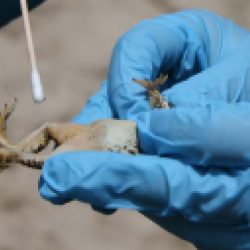Source Institutions
Source Institutions
Add to list Go to activity
Activity link broken? See if it's at the internet archive

In this field study, learners discover how to collect data in the field and how their efforts can help certain animals, specifically, amphibians. The field study allows learners to go into the field, collect data, and share it on Omaha's Henry Doorly Zoo Amphibian Database.
- Under 5 minutes
- 2 to 4 hours
- Over $20 per group of students
- Ages 8 - adult
- Activity, Experiment/Lab Activity, Field Trip, Lesson/Lesson Plan
- English
Quick Guide
Materials List (per group of students)
- GPS
- Digital camera
- Amphibian field guide for the area
- Waders
- Nets
- Cotton swabs (sterile swabs on 2mm-diameter plastic without adhesive)
- 2-mL tubes with screw caps
- 70% ethanol
- Powder-free nitrile or vinyl gloves
- 4 zip-loc bags
- 1 alcohol-resistant permanent marker
- Data forms and clip boards
- Water quality test kits
Subjects
-
Earth and Space Science
-
Earth Structure
- Oceans and Water
-
Earth Structure
-
Life Sciences
-
Diversity of Life
- Animals
- Protists and Fungi
-
Ecology
- Ecosystems
- Populations
- Human Impact
-
Diversity of Life
-
Mathematics
-
Data Analysis and Probability
- Data Analysis
- Data Collection
- Data Representation
-
Data Analysis and Probability
-
Physical Sciences
-
Chemistry
- Acids and Bases
- Chemistry of Life
-
Chemistry
-
The Nature of Science
-
Science and Society
- Risks and Benefits
-
The Scientific Process
- Conducting Investigations
- Gathering Data
- Formulating Explanations
- Communicating Results
- Science as a Career
-
Science and Society
-
The Nature of Technology
-
Technology and Society
- Impacts of Technology
- Technology and the Environment
-
Technology and Society
Informal Categories
- Animals
- Citizen Science
- Nature and Environment
- Outdoor Activity
Audience
To use this activity, learners need to:
- see
- read
- use keyboard
- use mouse
- be mobile
- touch
Learning styles supported:
- Involves teamwork and communication skills
- Uses STEM to solve real-world problems
- Involves hands-on or lab activities
Other
Components that are part of this resource:
This resource is part of:
Access Rights:
- Free access
By:
Rights:
- All rights reserved, Omaha's Henry Doorly Zoo, 2011
